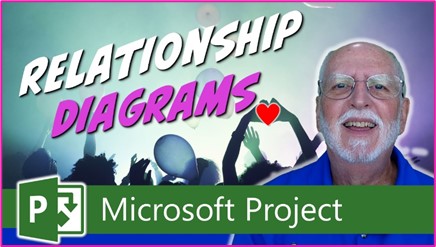Hey there! Today, I want to delve into a feature in Microsoft Project that might have caught your attention before, but you weren’t quite sure how to use it effectively – the Relationship Diagram View. I totally get it; it can seem a bit confusing at first glance. But fear not, because in this blog post, I’m going to show you how to harness the power of the Relationship Diagram View to analyze task dependency relationships in your projects. Let’s jump right in! If you prefer to watch the YouTube video on this subject, click here or click the thumbnail below.

Unveiling the Potential of the Relationship Diagram View
- Have you ever opened the Relationship Diagram View and felt like you were staring at a jumble of tasks with no clear direction? Trust me, you’re not alone. Most of us have been there, done that. But here’s the key: the Relationship Diagram View is not meant to be a stand-alone view. It’s designed to be used in combination with other views, like the Gantt chart view.
The Magic of Combination Views
- Let’s start with the magic of combination views. First, navigate to the “View” tab in Microsoft Project to display the View ribbon. Over on the right end, you’ll find the “Details” checkbox in the “Split View” section. Check that box and then click the pick list. From the dropdown, select “Relationship Diagram.”
- Now, here’s where the real power comes into play. Imagine you’re working on a project, and you’ve selected one particular task in the project. By using the combination of the Relationship Diagram View and the Gantt chart view, you can see the selected task’s direct predecessors on the left side and its direct successors on the right side of the Relationship Diagram view. This visual representation makes it so much easier to grasp task dependency relationships at a glance.
Unveiling Relationships Across Views
- But what if you’re working with a different view, like the Task Usage View? This is where the Relationship Diagram View continues to shine. In the Task Usage View, you’re dealing with a time-phased grid, and it’s not immediately clear how tasks are interconnected. No worries! Remember our trick? Check the “Details” checkbox in the “View” ribbon, choose “Relationship Diagram” from the pick list, and bam! Now, when you select a task, its direct predecessors and successors are displayed in the Relationship Diagram view, giving you a holistic understanding even in a more complex view like Task Usage.
From Resource View to Clarity
- Let’s level up further. Imagine you’re navigating the Resource Usage View, where tasks are assigned to resources. But alas, there’s no Gantt Chart screen in sight to help you understand task dependencies. Don’t lose hope! Once again, activate the “Details” checkbox, choose “Relationship Diagram” in the pick list, and voilà! Even in a resource-centric view, you can now see a task assignment’s direct predecessors and successors, providing clarity and insights that were once elusive.
And there you have it – the power of the Relationship Diagram view unlocked! Remember, the key is to use it in tandem with other views. Whether it’s the Gantt chart, Task Usage, or Resource Usage view, combining them with the Relationship Diagram view allows you to effortlessly decipher task dependency relationships.
If you have questions, please add them in the Comments section below. Or if you watch the video, add your questions or comments there. Please subscribe to my YouTube channel and leave “Likes” if you like the videos.
If you would like to have a formal class on using Microsoft Project, here is a link for my classes.
What Type of Microsoft Project Training Do You Need?
Individual and Small Group Training
OnDemand Training at your own pace
Starting at $399

OnDemand Training

Microsoft Project Standard Desktop Training

Microsoft Project Professional Desktop for Project Online Training

Microsoft Project Professional Desktop for Project Server Training

Templates, Student Hand Outs, Tips and Tricks

Certificate of Completion
Medium & Large Group Training
Onsite, Virtual or OnDemand Training
Contact Me for Discounts

Microsoft Project Standard Desktop Training

Microsoft Project Professional Desktop for Project Online Training

Microsoft Project Professional Desktop for Project Server Training

Templates, Student Hand Outs, Tips and Tricks

Certificate of Completion

Automated Training Progress Report
FAQ
What is Microsoft Project Dynamic Scheduling?
Microsoft Project Dynamic Scheduling is a feature within Microsoft Project that allows you to create flexible project plans, update schedules based on changing circumstances, and optimize resource allocation.
How can Microsoft Project Dynamic Scheduling benefit my project management?
Microsoft Project Dynamic Scheduling can benefit your project management by enabling efficient planning, increased productivity, and the ability to adapt to changes, allowing your projects to thrive.
What role does dynamic scheduling play in effective project management?
Dynamic scheduling plays a crucial role in effective project management by helping you stay on track, manage resources efficiently, and meet project goals.
What features does Microsoft Project offer for dynamic scheduling?
Microsoft Project offers various features and functions for dynamic scheduling, allowing you to create flexible project plans, update schedules in real-time, and optimize resource allocation.
How does dynamic scheduling optimize resource allocation?
Dynamic scheduling in Microsoft Project optimizes resource allocation by providing a flexible project schedule that can adapt to changes in resource availability, ensuring efficient utilization and maximizing productivity.
How does dynamic scheduling streamline project execution?
Dynamic scheduling streamlines project execution by providing a real-time, updated project schedule that enables effective communication, task prioritization, and timely decision-making throughout the project lifecycle.
How does dynamic scheduling enhance collaboration within Microsoft Project?
Dynamic scheduling enhances collaboration in Microsoft Project by offering collaborative features that promote effective communication, facilitate teamwork, and foster a shared understanding of project goals and progress among team members.
How does dynamic scheduling help track progress and manage risks?
Dynamic scheduling in Microsoft Project helps track progress and manage project risks by providing real-time updates and customizable reports that allow you to identify potential bottlenecks, mitigate risks, and take proactive actions to keep your project on track.
How can dynamic scheduling in Microsoft Project leverage data and insights for continuous improvement?
Dynamic scheduling in Microsoft Project provides valuable data and insights for continuous improvement by analyzing project performance metrics, identifying trends, and making data-driven decisions to enhance project outcomes and increase overall efficiency.

Leave a Reply